NCERT Solutions for Class 12 Maths Chapter 13 - Probability - Miscellaneous Exercise
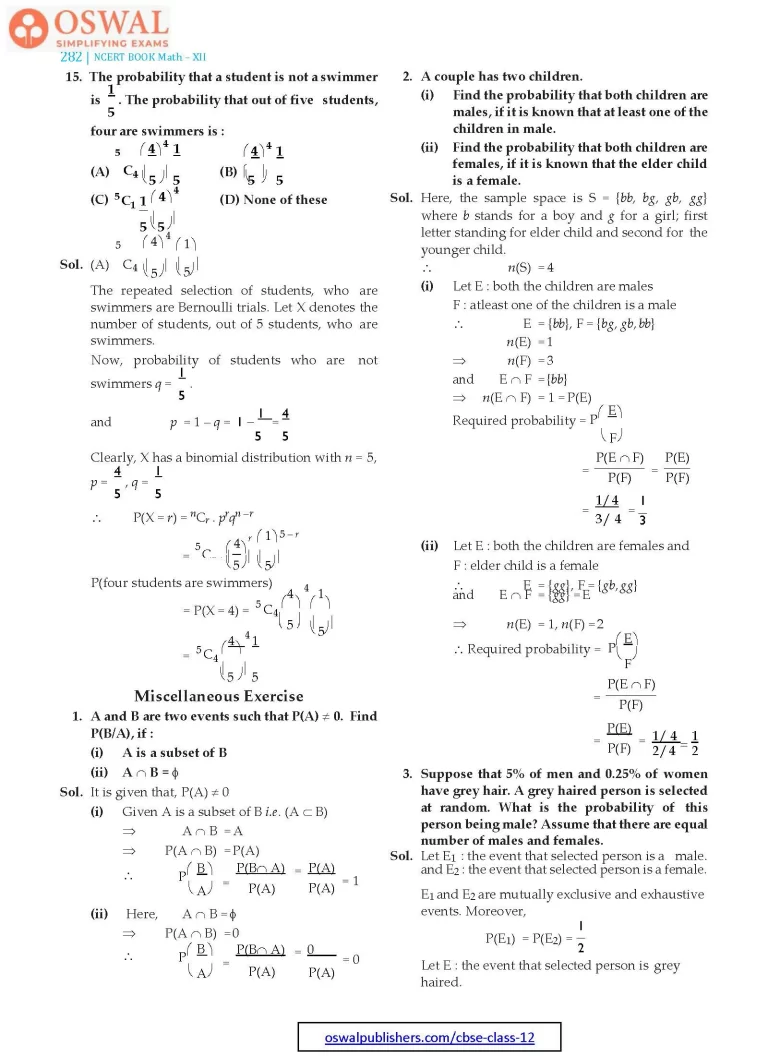
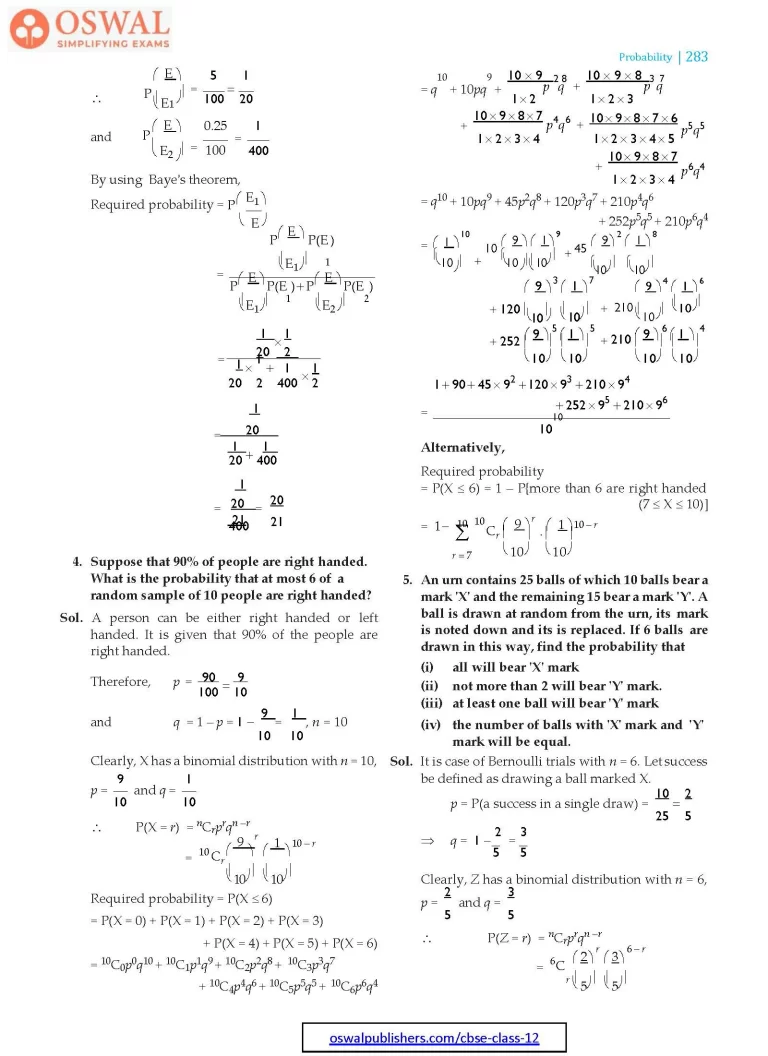
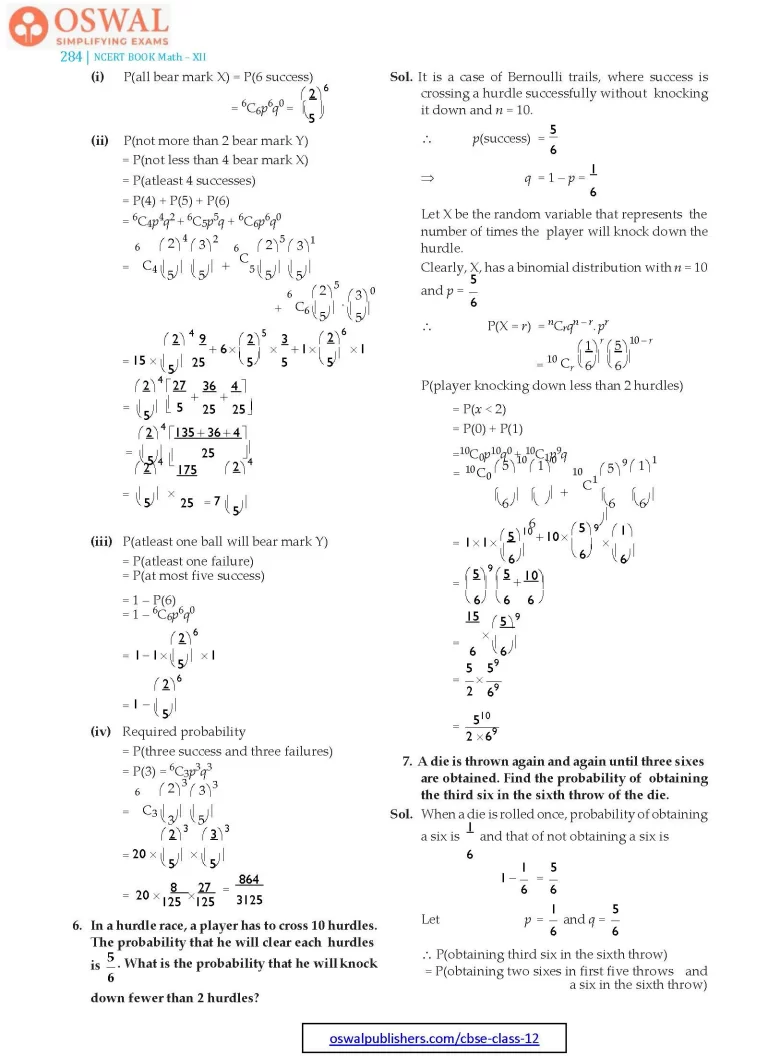
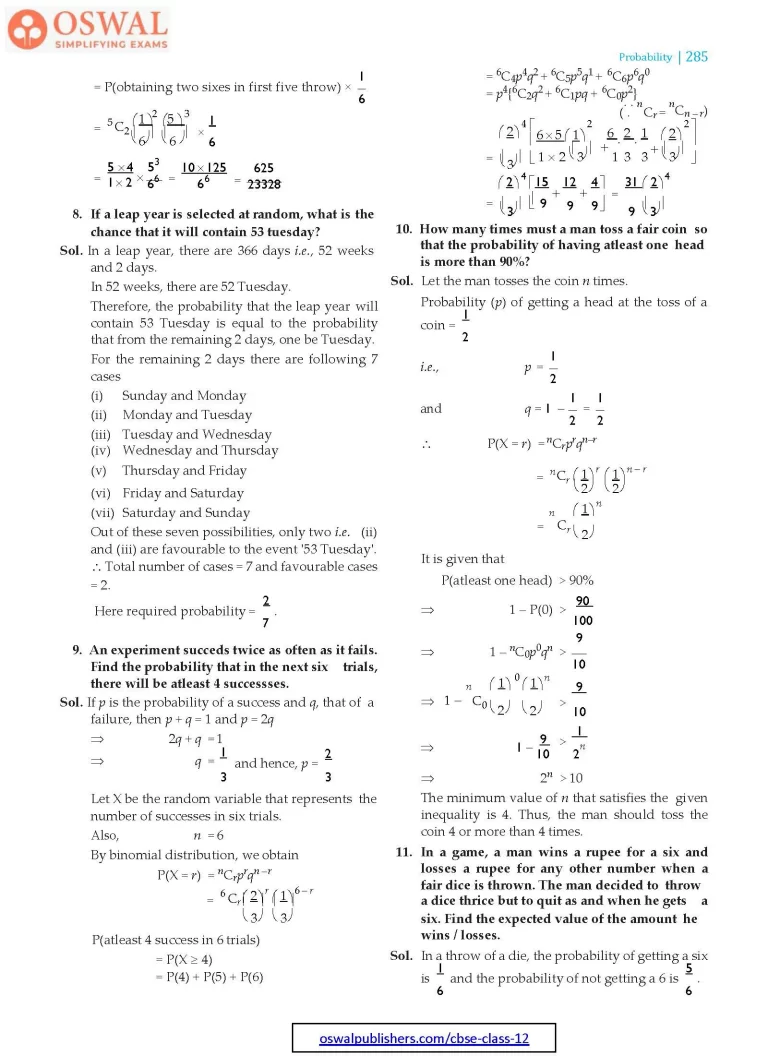
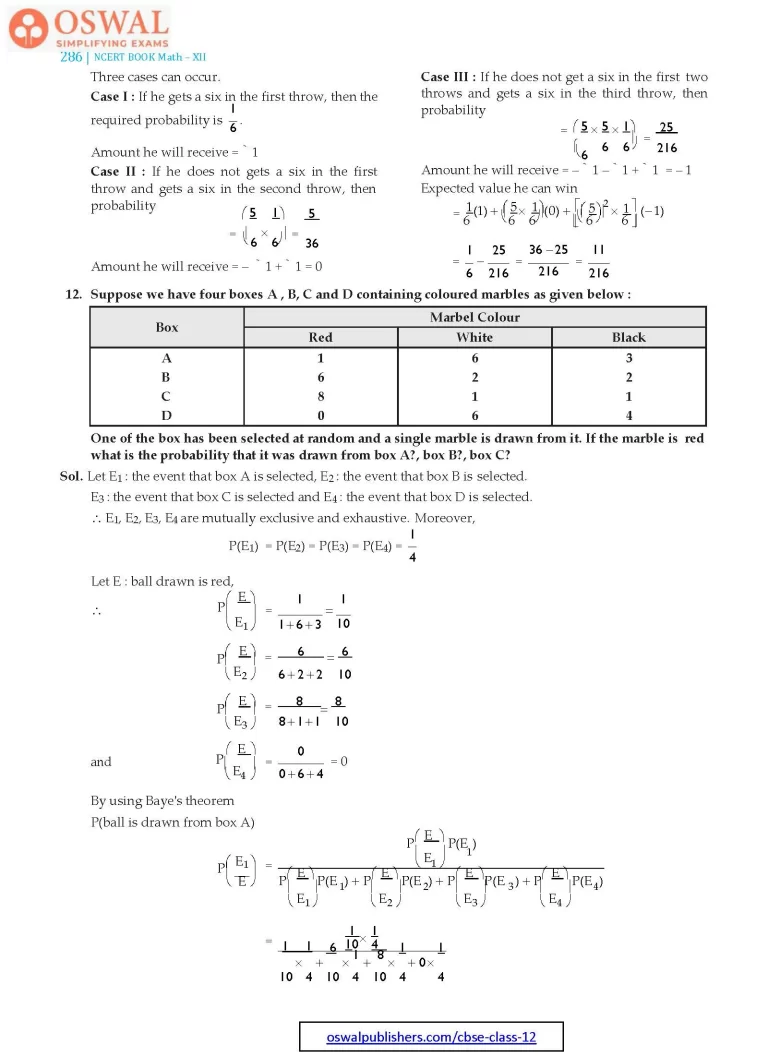
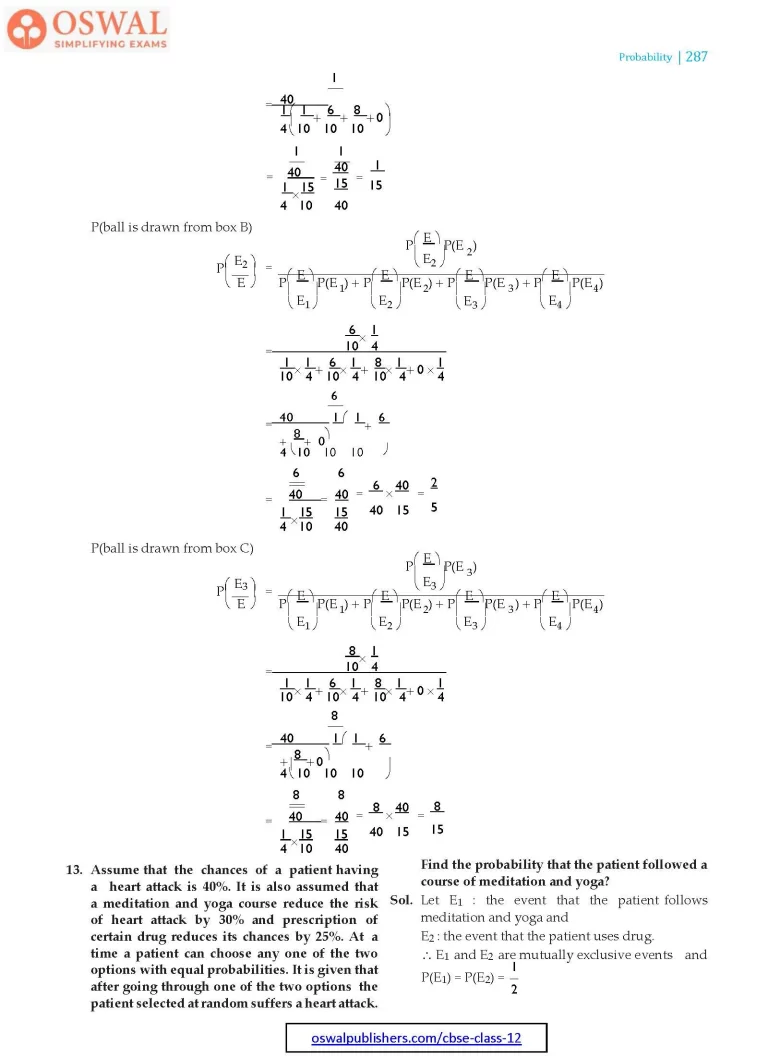
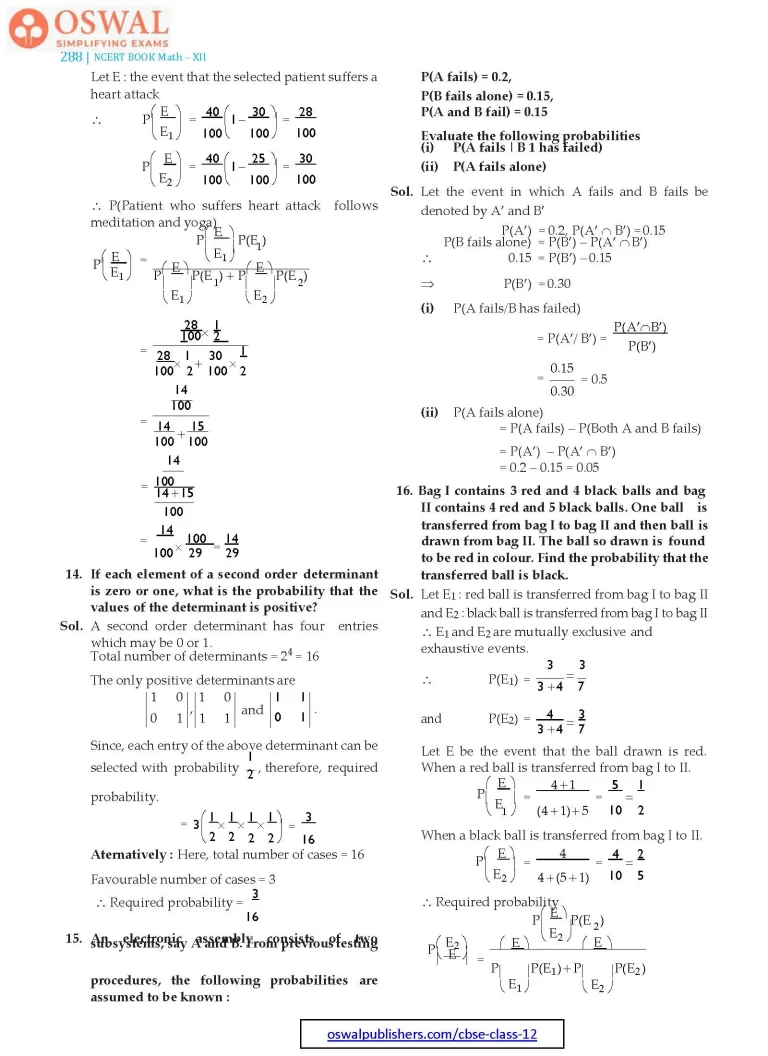
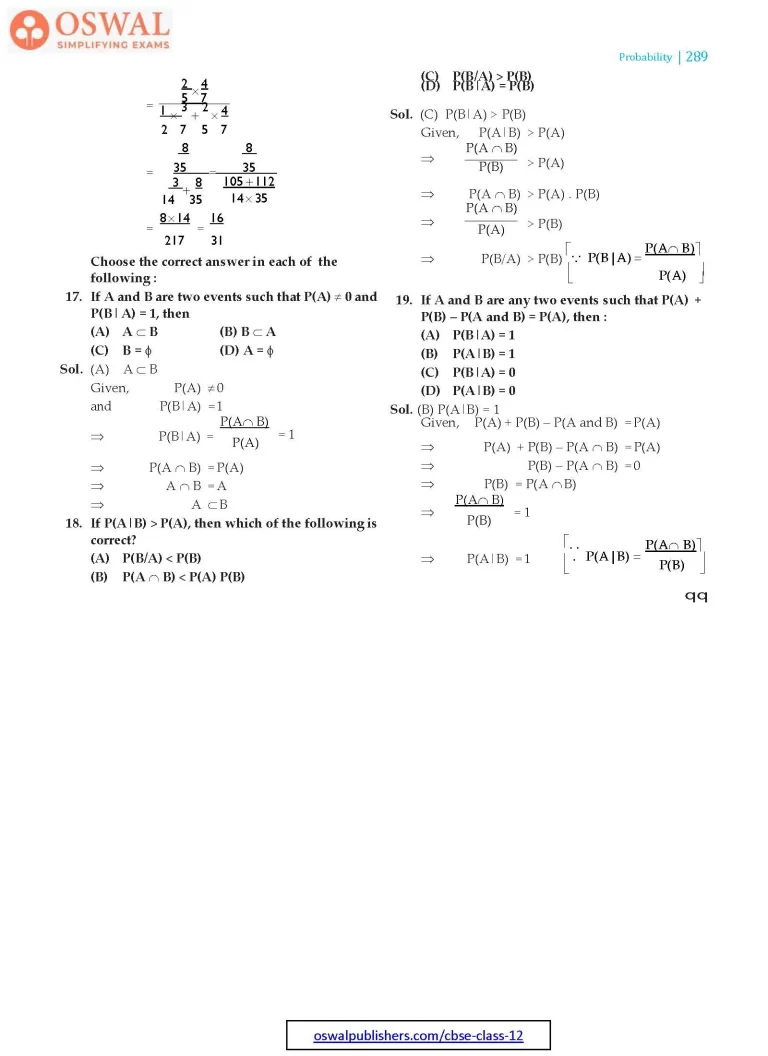
Access Exercises of Class 12 Maths Chapter 13 – Probability
Exercise 13.1 Solutions 17 Questions
Exercise 13.2 Solutions 18 Questions
Exercise 13.3 Solutions 14 Questions
Exercise 13.4 Solutions 17 Questions
Exercise 13.5 Solutions 15 Questions
Miscellaneous Exercise on Chapter 13 Solutions 10 Questions
Exercise Miscellaneous
1. A and B are two events such that P(A) ≠ 0. Find P(B/A), if :
(i) A is a subset of B
(ii) A ∩ B = Φ
Sol. It is given that, P(A) ≠ 0
(i) Given A is a subset of B i.e. (A ⊂ B)
$$\Rarr\space A\cap\text{B} = \text{A}\\\Rarr\space\text{P}(\text{A}\cap\text{B}) = \text{P(A)}\\\therefore\space\text{P}\bigg(\frac{B}{A}\bigg) = \frac{\text{P}(\text{B}\cap\text{A})}{\text{P(A)}}\\=\frac{\text{P(A)}}{\text{P(A)}}=1$$
(ii) Here, A ∩ B = Φ
⇒ P(A ∩ B) = 0
$$\therefore\space\text{P}\bigg(\frac{B}{A}\bigg)=\frac{\text{P}(\text{B}\cap \text{A})}{\text{P(A)}}\\=\frac{0}{\text{P(A)}} = 0 $$
2. A couple has two children.
(i) Find the probability that both children are males, if it is known that at least one of the children in male.
(ii) Find the probability that both children are females, if it is known that the elder child is a female.
Sol. Here, the sample space is S = {bb, bg, gb, gg} where b stands for a boy and g for a girl; first letter standing for elder child and second for the younger child.
∴ n(S) = 4
(i) Let E : both the children are males
F : atleast one of the children is a male
∴ E = {bb}, F = {bg, gb, bb}
n(E) = 1
⇒ n(F) = 3
and E ∩ F = {bb}
$$\Rarr\space n(\text{E}\cap\text{F}) = 1 = \text{P(E)}\\\text{Required probability = P}\bigg(\frac{\text{E}}{\text{F}}\bigg)\\=\frac{\text{P(E}\cap \text{F})}{\text{P(F)}} =\frac{\text{P(E)}}{\text{P(F)}}\\=\frac{1/4}{3/4}=\frac{1}{3}$$
(ii) Let E : both the children are females and
F : elder child is a female
∴ E = {gg}, F = {gb, gg}
and E ∩ F = {gg} = E
⇒ n(E) = 1, n(F) = 2
$$\therefore\space\text{Required probability =}\\=\space\text{P}\bigg(\frac{\text{E}}{\text{F}}\bigg)\\=\frac{\text{P(E}\cap \text{F})}{\text{P(F)}}\\=\frac{\text{P(E)}}{\text{P(F)}}=\frac{1/4}{2/4}=\frac{1}{2}$$
3. Suppose that 5% of men and 0.25% of women have grey hair. A grey haired person is selected at random. What is the probability of this person being male? Assume that there are equal number of males and females.
Sol. Let E1 : the event that selected person is a male. and E2 : the event that selected person is a female.
E1 and E2 are mutually exclusive and exhaustive events. Moreover,
$$\text{P(E}_1) = \text{P(\text{E}}_2)=\frac{1}{2}$$
Let E : the event that selected person is grey haired.
$$\therefore\space \text{P}\bigg(\frac{E}{\text{E}_1}\bigg) = \frac{5}{100}=\frac{1}{20}\\\text{and\space}\text{P}\bigg(\frac{\text{E}}{\text{E}_2}\bigg) =\frac{0.25}{100}\\=\frac{1}{400}$$
By using Baye's theorem,
$$\text{Required probability =}\space\text{P}\bigg(\frac{\text{E}_1}{\text{E}}\bigg)\\=\frac{\text{P}\bigg(\frac{\text{E}}{\text{E}_1}\bigg)\text{P}(\text{E}_1)}{\text{P}\bigg(\frac{\text{E}}{\text{E}_1}\bigg)\text{P}(\text{E}_1) + \text{P}\bigg(\frac{E}{\text{E}_2}\bigg)\text{P}(\text{E}_2)}\\=\frac{\frac{1}{20}×\frac{1}{2}}{\frac{1}{20}×\frac{1}{2} + \frac{1}{400}×\frac{1}{2}}\\=\frac{\frac{1}{20}}{\frac{1}{20} + \frac{1}{400}}\\=\frac{\frac{1}{20}}{\frac{21}{400}}=\frac{20}{21}$$
4. Suppose that 90% of people are right handed. What is the probability that at most 6 of a random sample of 10 people are right handed?
Sol. A person can be either right handed or left handed. It is given that 90% of the people are right handed.
$$\text{Therefore,}\space\text{p} = \frac{90}{100}=\frac{9}{10}\\\text{and\space}\text{q = 1-p}\\= 1-\frac{9}{10}=\frac{1}{10}, n = 10$$
Clearly, X has a binomial distribution with n = 10,
$$p = \frac{9}{10}\text{and}\space q =\frac{1}{10}\\\therefore\space \text{P}(X=r) = \space^{n}\text{C}_{r}p^{r}q^{n-r}\\=\space^{10}\text{C}_{r}\bigg(\frac{9}{100}\bigg)^{r}\bigg(\frac{1}{10}\bigg)^{10-r}$$
Required probability = P(X ≤ 6)
= P(X = 0) + P(X = 1) + P(X = 2) + P(X = 3) + P(X = 4) + P(X = 5) + P(X = 6)
= 10C0p0q10 + 10C1p1q9 + 10C2p2q8 + 10C3p3q7+ 10C4p4q6 + 10C5p5q5 + 10C6p6q4
$$= q^{10} + 10pq^{9} + \frac{10×9}{1×2}p^{2}q^{8} +\\ \frac{10×9×8}{1×2×3}p^{3}q^{7} + \frac{10×9×8×7}{1×2×3×4}p^{4}q^{6}+\\\frac{10×9×8×7×6}{1×2×3×4×5}p^{5}q^{5}+\\\frac{10×9×8×7}{1×2×3×4}p^{6}q^{4}$$
= q10 + 10pq9 + 45p2q8 + 120p3q7 + 210p4q6 + 252p5q5 + 210p6q4
$$= \bigg(\frac{1}{10}\bigg)^{10} + 10\bigg(\frac{9}{10}\bigg)\bigg(\frac{1}{10}\bigg)^{9}+\\ 45\bigg(\frac{9}{10}\bigg)^{2}\bigg(\frac{1}{10}\bigg)^{8}+ \\120\bigg(\frac{9}{10}\bigg)^{3}\bigg(\frac{1}{10}\bigg)^{7} + 210\bigg(\frac{9}{10}\bigg)^{4}\bigg(\frac{1}{10}\bigg)^{6}+\\252\bigg(\frac{9}{10}\bigg)^{5}\bigg(\frac{1}{10}\bigg)^{5} +\\ 210\bigg(\frac{9}{10}\bigg)^{6}\bigg(\frac{1}{10}\bigg)^{4}$$
$$=\frac{1 + 90 + 45×9^{2} + 120×9^{3} +210×9^{4} + 252×9^{5}+ 210×9^{6}}{10^{10}}$$
Alternatively,
Required probability
= P(X ≤ 6) = 1 – P{more than 6 are right handed (7 ≤ X ≤ 10)]
$$= 1-\sum^{10}_{\text{r=7}}\space^{10}\text{C}_{r}\bigg(\frac{9}{10}\bigg)^{r}.\bigg(\frac{1}{10}\bigg)^{10-r}$$
5. An urn contains 25 balls of which 10 balls bear a mark 'X' and the remaining 15 bear a mark 'Y'. A ball is drawn at random from the urn, its mark is noted down and its is replaced. If 6 balls are drawn in this way, find the probability that
(i) all will bear 'X' mark
(ii) not more than 2 will bear 'Y' mark.
(iii) at least one ball will bear 'Y' mark
(iv) the number of balls with 'X' mark and 'Y' mark will be equal.
Sol. It is case of Bernoulli trials with n = 6. Let success be defined as drawing a ball marked X.
p = P(a success in a single draw)
$$=\frac{10}{25} =\frac{2}{5}\\\Rarr\space q = 1-\frac{2}{5}=\frac{3}{5}$$
Clearly, Z has a binomial distribution with n = 6,
$$p =\frac{2}{5}\text{and q} = \frac{3}{5}$$
∴ P(Z = r) = nCrprqn – r
$$= \space^{6}\text{C}_{r}\bigg(\frac{2}{5}\bigg)^{r}\bigg(\frac{3}{5}\bigg)^{6-r}$$
(i) P(all bear mark X) = P(6 success)
$$=\space^{6}\text{C}_{6}p^{6}q^{0} =\bigg(\frac{2}{5}\bigg)^{6}$$
(ii) P(not more than 2 bear mark Y)
= P(not less than 4 bear mark X)
= P(atleast 4 successes)
= P(4) + P(5) + P(6)
= 6C4p4q2 + 6C5p5q + 6C6p6q0
$$=\space^{6}\text{C}_{4}\bigg(\frac{2}{5}\bigg)^{4}\bigg(\frac{3}{5}\bigg)^{2} + \space^{6}\text{C}_{5}\bigg(\frac{2}{5}\bigg)^{5}\bigg(\frac{3}{5}\bigg)^{1}\\+^{6}\text{C}_{6}\bigg(\frac{2}{5}\bigg)^{5}.\bigg(\frac{3}{5}\bigg)^{0}$$
$$= 15×\bigg(\frac{2}{5}\bigg)^{4}\frac{9}{25} + 6×\bigg(\frac{2}{5}\bigg)^{5}×\frac{3}{5}+\\ 1×\bigg(\frac{2}{5}\bigg)^{6}×1\\=\bigg(\frac{2}{5}\bigg)^{4}\bigg[\frac{27}{5} +\frac{36}{25} + \frac{4}{25}\bigg]\\=\bigg(\frac{2}{5}\bigg)^{4}\bigg[\frac{135 + 36 +4}{25}\bigg]\\=\bigg(\frac{2}{5}\bigg)^{4}×\frac{175}{25} = 7\bigg(\frac{2}{5}\bigg)^{4}$$
(iii) P(atleast one ball will bear mark Y)
= P(atleast one failure)
= P(at most five success)
= 1 – P(6)
= 1 – 6C6p6q0
$$= 1-1×\bigg(\frac{2}{5}\bigg)^{6}×1\\=1 -\bigg(\frac{2}{5}\bigg)^{6}$$
(iv) Required probability
= P(three success and three failures)
= P(3) = 6C3p3q3
$$= \space^{6}\text{C}_{3}\bigg(\frac{2}{3}\bigg)^{3}\bigg(\frac{3}{5}\bigg)^{3}\\= 20×\bigg(\frac{2}{5}\bigg)^{3}×\bigg(\frac{3}{5}\bigg)^{3}\\= 20×\frac{8}{125}×\frac{27}{125}\\=\frac{864}{3125}$$
6. In a hurdle race, a player has to cross 10 hurdles. The probability that he will clear each hurdles is
$$\frac{\textbf{5}}{\textbf{6}}\textbf{.}\space\textbf{What is the probability}$$
that he will knock down fewer than 2 hurdles?
Sol. It is a case of Bernoulli trails, where success is crossing a hurdle successfully without knocking it down and n = 10.
$$\therefore\space\text{p(success)} = \frac{5}{6}\\\Rarr\space q = 1-p=\frac{1}{6} $$
Let X be the random variable that represents the number of times the player will knock down the hurdle.
Clearly, X, has a binomial distribution with n = 10
and
$$p = \frac{5}{6}\\\therefore\space \text{P(X= r)} = \space^{n}\text{C}_{r}q^{n-r}.p^{r}\\=\space^{10}\text{C}_{r}\bigg(\frac{1}{6}\bigg)^{r}\bigg(\frac{5}{6}\bigg)^{10-r}$$
P(player knocking down less than 2 hurdles)
= P(x < 2)
= P(0) + P(1)
= 10C0p10q0 + 10C1p9q
$$= \space^{10}\text{C}_{0}\bigg(\frac{5}{6}\bigg)^{10}\bigg(\frac{1}{6}\bigg)^{0}+\\{^{10}\text{C}_{1}}\bigg(\frac{5}{6}\bigg)^{9}\bigg(\frac{1}{6}\bigg)^{1}\\=1×1×\bigg(\frac{5}{6}\bigg)^{10}+\\10×\bigg(\frac{5}{6}\bigg)^{9}×\bigg(\frac{1}{6}\bigg)\\=\bigg(\frac{5}{6}\bigg)^{9}\bigg(\frac{5}{6}+\frac{10}{6}\bigg)\\=\frac{15}{6}×\bigg(\frac{5}{6}\bigg)^{9}$$
$$=\frac{5}{2}×\frac{5^{9}}{6^{9}}\\=\frac{5^{10}}{2×6^{9}}$$
7. A die is thrown again and again until three sixes are obtained. Find the probability of obtaining the third six in the sixth throw of the die.
Sol. When a die is rolled once, probability of obtaining a six is
$$\frac{1}{6}\space\text{and that of not obtaining}\\\text{a six is}$$
$$1 -\frac{1}{6} =\frac{5}{6}\\\text{Let\space} p =\frac{1}{6}\text{and q} = \frac{5}{6}$$
∴ P(obtaining third six in the sixth throw)
= P(obtaining two sixes in first five throws and a six in the sixth throw)
$$\text{= P(obtaining two sixes in first five throw)}\\×\frac{1}{6}\\=\space^{5}\text{C}_{2}\bigg(\frac{1}{6}\bigg)^{2}\bigg(\frac{5}{6}\bigg)^{3}×\frac{1}{6}\\=\frac{5×4}{1×2}×\frac{5^{3}}{6^{6}} \\=\frac{10×125}{6^{6}}=\frac{625}{23328}$$
8. If a leap year is selected at random, what is the chance that it will contain 53 tuesday?
Sol. In a leap year, there are 366 days i.e., 52 weeks and 2 days.
In 52 weeks, there are 52 Tuesday.
Therefore, the probability that the leap year will contain 53 Tuesday is equal to the probability that from the remaining 2 days, one be Tuesday.
For the remaining 2 days there are following 7 cases
(i) Sunday and Monday
(ii) Monday and Tuesday
(iii) Tuesday and Wednesday
(iv) Wednesday and Thursday
(v) Thursday and Friday
(vi) Friday and Saturday
(vii) Saturday and Sunday
Out of these seven possibilities, only two i.e. (ii) and (iii) are favourable to the event '53 Tuesday'.
∴ Total number of cases = 7 and favourable cases = 2.
$$\text{Here required probability =}\frac{2}{7}.$$
9. An experiment succeds twice as often as it fails. Find the probability that in the next six trials, there will be atleast 4 successses.
Sol. If p is the probability of a success and q, that of a failure, then p + q = 1 and p = 2q
$$\Rarr\space 2q +q =1\\\Rarr\space q = \frac{1}{3}\text{and hence,}\space p=\frac{2}{3}$$
Let X be the random variable that represents the number of successes in six trials.
Also, n = 6
By binomial distribution, we obtain
P(X = r) = nCrprqn – r
$$= \space^{6}\text{C}_{r}\bigg(\frac{2}{3}\bigg)^{r}\bigg(\frac{1}{3}\bigg)^{6-r}$$
P(atleast 4 success in 6 trials)
= P(X ≥ 4)
= P(4) + P(5) + P(6)
= 6C4p4q2 + 6C5p5q1 + 6C6p6q0
= p4{6C2q2 + 6C1pq + 6C0p2}
(∵ nCr = nCn – r)
$$=\bigg(\frac{2}{3}\bigg)^{4}\begin{bmatrix}\frac{6×5}{1×2}\bigg(\frac{1}{3}\bigg)^{2} + \\\frac{6}{1}.\frac{2}{3}.\frac{1}{3} + \bigg(\frac{2}{3}\bigg)^{2}\end{bmatrix}\\=\bigg(\frac{2}{3}\bigg)^{4}\bigg[\frac{15}{9}+\frac{12}{9}+ \frac{4}{9}\bigg]\\=\frac{31}{9}\bigg(\frac{2}{3}\bigg)^{4}$$
10. How many times must a man toss a fair coin so that the probability of having atleast one head is more than 90%?
Sol. Let the man tosses the coin n times.
Probability (p) of getting a head at the toss of a
$$\text{coin} = \frac{1}{2}\\\therefore\space p = \frac{1}{2}\\\text{and} \space q =1-\frac{1}{2}=\frac{1}{2}\\\therefore\space\text{P}(X=r) =\space^{n}\text{C}_{r}p^{r}q^{n-r}\\=\space^{n}\text{C}_{r}\bigg(\frac{1}{2}\bigg)^{r}\bigg(\frac{1}{2}\bigg)^{n-r}\\=\space^{n}\text{C}_{r}\bigg(\frac{1}{2}\bigg)^{n}$$
It is given that
P(atleast one head) > 90%
$$\Rarr\space 1 - \text{P(0)}\gt\frac{90}{100}\\\Rarr\space 1 -\space^{n}\text{C}_{0}p^{0}q^{n}\gt\frac{9}{10}\\\Rarr\space 1-\space^{n}\text{C}_{0}\bigg(\frac{1}{2}\bigg)^{0}\bigg(\frac{1}{2}\bigg)^{n}\gt\frac{9}{10}\\\Rarr\space 1-\frac{9}{10}\gt\frac{1}{2^{n}}\\\Rarr\space 2^{n}\gt 10$$
The minimum value of n that satisfies the given inequality is 4. Thus, the man should toss the coin 4 or more than 4 times.
11. In a game, a man wins a rupee for a six and losses a rupee for any other number when a fair dice is thrown. The man decided to throw a dice thrice but to quit as and when he gets a six. Find the expected value of the amount he wins / losses.
Sol. In a throw of a die, the probability of getting a six is
$$\frac{1}{6}\space\text{and the probability of not}\\\text{getting a 6 is}\space\frac{5}{6}.$$
Three cases can occur.
Case I : If he gets a six in the first throw, then the required probability is $$\frac{1}{6}.$$
Amount he will receive = ₹ 1
Case II : If he does not gets a six in the first throw and gets a six in the second throw, then probability
$$=\bigg(\frac{5}{6}×\frac{1}{6}\bigg)=\frac{5}{36}$$
Amount he will receive = – ₹ 1 + ₹ 1 = 0
Case III : If he does not get a six in the first two throws and gets a six in the third throw, then probability
$$=\bigg(\frac{5}{6}×\frac{5}{6}×\frac{1}{6}\bigg)=\frac{25}{216}$$
Amount he will receive = – ₹ 1 – ₹ 1 + ₹ 1 = – 1
Expected value he can win
$$=\frac{1}{6}(1) + \bigg(\frac{5}{6}×\frac{1}{6}\bigg)(0) +\\\bigg[\bigg(\frac{5}{6}\bigg)^{2}×\frac{1}{6}\bigg](\normalsize-1)\\=\frac{1}{6}-\frac{25}{216}\\=\frac{36-25}{216} = \frac{11}{216} $$
12. Suppose we have four boxes A , B, C and D containing coloured marbles as given below :
| Red | White | Black | |
| A | 1 | 6 | 3 |
| B | 6 | 2 | 2 |
| C | 8 | 1 | 1 |
| D | 0 | 6 | 4 |
One of the box has been selected at random and a single marble is drawn from it. If the marble is red what is the probability that it was drawn from box A?, box B?, box C?
Sol. Let E1 : the event that box A is selected, E2 : the event that box B is selected.
E3 : the event that box C is selected and E4 : the event that box D is selected.
∴ E1, E2, E3, E4 are mutually exclusive and exhaustive. Moreover,
$$\text{P}(\text{E}_1) =\text{P}(\text{E}_2) =\text{P}(\text{E}_3)\\= \text{P}(\text{E}_4)=\frac{1}{4}$$
Let E : ball drawn is red,
$$\therefore\space \text{P}\bigg(\frac{\text{E}}{\text{E}_1}\bigg)=\frac{1}{1 +6+3}=\frac{1}{10}\\\text{P}\bigg(\frac{E}{\text{E}_2}\bigg)=\frac{6}{6+2+2}= \frac{6}{10}\\\text{P}\bigg(\frac{\text{E}}{\text{E}_3}\bigg) = \frac{8}{8+1+1}=\frac{8}{10}\\\text{and}\\\space\text{P}\bigg(\frac{E}{\text{E}_4}\bigg) =\frac{0}{0 +6+4}=0$$
By using Baye's theorem
P(ball is drawn from box A)
$$\text{P}\bigg(\frac{\text{E}_1}{\text{E}}\bigg)=\\\frac{\text{P}\bigg(\frac{E}{\text{E}_1}\bigg)\text{P}(\text{E}_1)}{\text{P}\bigg(\frac{\text{E}}{\text{E}_1}\bigg)\text{P}(\text{E}_1) + \text{P}\bigg(\frac{E}{\text{E}_2}\bigg)\text{P}(\text{E}_{2}) + P\bigg(\frac{\text{E}}{\text{E}_3}\bigg)\text{P}(\text{E}_{3}) + \text{P}\bigg(\frac{\text{E}}{\text{E}_{4}}\bigg)\text{P}(\text{E}_{4})}$$
$$=\frac{\frac{1}{10}×\frac{1}{4}}{\frac{1}{10}×\frac{1}{4} + \frac{6}{10}×\frac{1}{4} +\frac{8}{10}×\frac{1}{4} + 0×\frac{1}{4}}\\=\frac{\frac{1}{40}}{\frac{1}{4}\bigg(\frac{1}{10} + \frac{6}{10}+ \frac{8}{10} + 0\bigg)}\\=\frac{\frac{1}{40}}{\frac{1}{4}×\frac{15}{10}}=\frac{\frac{1}{40}}{\frac{15}{40}}=\frac{1}{15}$$
P(ball is drawn from box B)
$$\text{P}\bigg(\frac{\text{E}_2}{\text{E}}\bigg) =\\ \frac{\text{P}\bigg(\frac{\text{E}}{\text{E}_2}\bigg)\text{P}(\text{E}_{2})}{\text{P}\bigg(\frac{\text{E}}{\text{E}_{1}}\bigg)\text{P}(\text{E}_{1}) + \text{P}\bigg(\frac{\text{E}}{\text{E}_{2}}\bigg)\text{P}(\text{E}_{2}) + \text{P}\bigg(\frac{\text{E}}{\text{E}_{3}}\bigg)\text{P}(\text{E}_{3}) + \text{P}\bigg(\frac{\text{E}}{\text{E}_{4}}\bigg)\text{P(\text{E}}_{4})}$$
$$= \frac{\frac{6}{10}×\frac{1}{4}}{\frac{1}{10}×\frac{1}{4} + \frac{6}{10}×\frac{1}{4}+ \frac{8}{10}×\frac{1}{4} + 0×\frac{1}{4}}\\=\frac{\frac{6}{40}}{\frac{1}{4}\bigg(\frac{1}{10} + \frac{6}{10} + \frac{8}{10} +0\bigg)}\\=\frac{\frac{6}{40}}{\frac{1}{4}×\frac{15}{10}}=\frac{\frac{6}{40}}{\frac{15}{40}}\\=\frac{6}{40}×\frac{40}{15}=\frac{2}{5}$$
P(ball is drawn from box C)
$$\text{P}\bigg(\frac{\text{E}_{3}}{\text{E}}\bigg) =\\\frac{\text{P}\bigg(\frac{\text{E}}{\text{E}_{3}}\bigg)\text{P}(\text{E}_{3})}{\text{P}\bigg(\frac{\text{E}}{\text{E}_{1}}\bigg)\text{P}(\text{E}_{1}) + \text{P}\bigg(\frac{\text{E}}{\text{E}_{2}}\bigg)\text{P}(\text{E}_{2})+\\\text{P}\bigg(\frac{\text{E}}{\text{E}_{3}}\bigg) \text{P}(\text{E}_{3}) + \text{P}\bigg(\frac{\text{E}}{\text{E}_{4}}\bigg)\text{P}(\text{E}_{4})}\\=\\\frac{\frac{8}{10}×\frac{1}{4}}{\frac{1}{10}×\frac{1}{4} + \frac{6}{10}×\frac{1}{4} + \frac{8}{10}×\frac{1}{4} + 0×\frac{1}{4}}$$
$$=\frac{\frac{8}{40}}{\frac{1}{4}\bigg(\frac{1}{10} + \frac{6}{10} +\frac{8}{10} + 0\bigg)}\\=\frac{\frac{8}{40}}{\frac{1}{4}×\frac{15}{10}}=\frac{\frac{8}{40}}{\frac{15}{40}}\\=\frac{8}{40}×\frac{40}{15}=\frac{8}{15}$$
13. Assume that the chances of a patient having a heart attack is 40%. It is also assumed that a meditation and yoga course reduce the risk of heart attack by 30% and prescription of certain drug reduces its chances by 25%. At a time a patient can choose any one of the two options with equal probabilities. It is given that after going through one of the two options the patient selected at random suffers a heart attack.
Find the probability that the patient followed a course of meditation and yoga?
Sol. Let E1 : the event that the patient follows meditation and yoga and
E2 : the event that the patient uses drug.
∴ E1 and E2 are mutually exclusive events and
$$\text{P(\text{E}}_{1}) =\text{P(\text{E}}_{2})=\frac{1}{2}$$
Let E : the event that the selected patient suffers a heart attack
$$\therefore\space\text{P}\bigg(\frac{\text{E}}{\text{E}_{1}}\bigg)=\\\frac{40}{100}\bigg(1-\frac{30}{100}\bigg)=\frac{28}{100}\\\text{P}\bigg(\frac{\text{E}}{\text{E}_{2}}\bigg)=\\\frac{40}{100}\bigg(1 - \frac{25}{100}\bigg)=\frac{30}{100}$$
∴ P(Patient who suffers heart attack follows meditation and yoga)
$$\text{P}\bigg(\frac{\text{E}}{\text{E}_{1}}\bigg) =\\\frac{\text{P}\bigg(\frac{\text{E}}{\text{E}_{1}}\bigg)\text{P(E}_{1})}{\text{P}\bigg(\frac{\text{E}}{\text{E}_{1}}\bigg)\text{P}(\text{E}_{1}) + \text{P}\bigg(\frac{\text{E}}{\text{E}_{2}}\bigg)\text{P}(\text{E}_{2})}$$
$$= \frac{\frac{28}{100}×\frac{1}{2}}{\frac{28}{100}×\frac{1}{2} + \frac{30}{100}×\frac{1}{2}}\\=\frac{\frac{14}{100}}{\frac{14}{100} + \frac{15}{100}}\\=\frac{\frac{14}{100}}{\frac{14+15}{100}}\\=\frac{14}{100}×\frac{100}{29} =\frac{14}{29}$$
14. If each element of a second order determinant is zero or one, what is the probability that the values of the determinant is positive?
Sol. A second order determinant has four entries
which may be 0 or 1.
Total number of determinants = 24 = 16
The only positive determinants are
$$\begin{vmatrix}1 &0\\0&1\end{vmatrix},\begin{vmatrix} 1&0\\1&1\end{vmatrix}\\\text{and}\space\begin{vmatrix}1 &1\\0&1\end{vmatrix}.$$
Since, each entry of the above determinant can be selected with probability
$$\frac{1}{2},\space\text{therefore, required probability.}$$
$$= 3\bigg(\frac{1}{2}×\frac{1}{2}×\frac{1}{2}×\frac{1}{2}\bigg)\\=\frac{3}{16}$$
Aternatively : Here, total number of cases = 16
Favourable number of cases = 3
$$\therefore\space\text{Required probability =}\frac{3}{16}$$
15. An electronic assembly consists of two subsystems, say A and B. From previous testing procedures, the following probabilities are assumed to be known :
P(A fails) = 0.2,
P(B fails alone) = 0.15,
P(A and B fail) = 0.15
Evaluate the following probabilities
(i) P(A fails | B 1 has failed)
(ii) P(A fails alone)
Sol. Let the event in which A fails and B fails be denoted by A′ and B′
P(A′) = 0.2, P(A′ ∩ B′) = 0.15
P(B fails alone) = P(B′) – P(A′ ∩ B′)
∴ 0.15 = P(B′) – 0.15
⇒ P(B′) = 0.30
(i) P(A fails/B has failed)
$$\text{= P(A}^{′}/ B^{′}) =\frac{\text{P}(A^{'}\cap B^{'})}{\text{P(B}^{'})}\\=\frac{0.15}{0.30}=0.5$$
(ii) P(A fails alone)
= P(A fails) – P(Both A and B fails)
= P(A′) – P(A′ ∩ B′)
= 0.2 – 0.15 = 0.05
16. Bag I contains 3 red and 4 black balls and bag II contains 4 red and 5 black balls. One ball is transferred from bag I to bag II and then ball is drawn from bag II. The ball so drawn is found to be red in colour. Find the probability that the transferred ball is black.
Sol. Let E1 : red ball is transferred from bag I to bag II
and E2 : black ball is transferred from bag I to bag II
∴ E1 and E2 are mutually exclusive and exhaustive events.
$$\therefore\space\text{P}(\text{E}_{1})=\frac{3}{3+4}=\frac{3}{7}\\\text{and}\space\text{P(\text{E}}_{2}) =\frac{4}{3+4}=\frac{3}{7}$$
Let E be the event that the ball drawn is red. When a red ball is transferred from bag I to II.
$$\text{P}\bigg(\frac{\text{E}}{\text{E}_{1}}\bigg)=\frac{4+1}{(4+1)+5}\\=\frac{5}{10}=\frac{1}{2}$$
When a black ball is transferred from bag I to II.
$$\text{P}\bigg(\frac{\text{E}}{\text{E}_{2}}\bigg)=\frac{4}{4 + (5+1)}\\=\frac{4}{10}=\frac{2}{5}$$
∴ Required probability
$$\text{P}\bigg(\frac{\text{E}_{2}}{\text{E}}\bigg)\\=\frac{\text{P}\bigg(\frac{\text{E}}{\text{E}_{2}}\bigg)\text{P}(\text{E}_{2})}{\text{P}\bigg(\frac{\text{E}}{\text{E}_{1}}\bigg)\text{P(E}_{1}) + \text{P}\bigg(\frac{\text{E}}{\text{E}_{2}}\bigg)\text{P(E}_{2})}\\=\frac{\frac{2}{5}×\frac{4}{7}}{\frac{1}{2}×\frac{3}{7} + \frac{2}{5}×\frac{4}{7}}\\=\frac{\frac{8}{35}}{\frac{3}{14} + \frac{8}{35}}\\=\frac{\frac{8}{35}}{\frac{105+11+2}{14×35}}\\=\frac{8×14}{217}=\frac{16}{31}$$
Choose the correct answer in each of the following :
17. If A and B are two events such that P(A) ≠ 0 and P(B | A) = 1, then
(A) A ⊂ B
(B) B ⊂ A
(C) B = f
(D) A = f
Sol. (A) A ⊂ B
Given, P(A) ≠ 0
and P(B|A) = 1
$$\Rarr\space \text{P(B|A)} = \frac{\text{P(A}\cap B)}{\text{P(A)}}\\=1\\\Rarr\space \text{P(A}\cap B) = \text{P(A)}\\\Rarr\space\text{A}\cap\text{B} = A\\\Rarr\space\text{A}\sub\text{B}$$
18. If P(A|B) > P(A), then which of the following is correct?
(A) P(B/A) < P(B)
(B) P(A ∩ B) < P(A) P(B)
(C) P(B/A) > P(B)
(D) P(B|A) = P(B)
Sol. (C) P(B|A) > P(B)
Given, P(A|B) > P(A)
$$\Rarr\space\frac{\text{P}(A\cap B)}{\text{P(B)}}\gt\text{P(A)}\\\Rarr\space \text{P}(A\cap B) \gt\text{P(A)}.\text{P(B)}\\\Rarr\space\frac{\text{P(A}\cap B)}{\text{P(A)}}\gt\text{P(B)}\\\Rarr\space\text{P(B/A)}\gt\text{P(B)}\\\bigg[\because\space\text{P(B|A)} =\frac{\text{P}(A\cap B)}{\text{P(A)}}\bigg]$$
19. If A and B are any two events such that P(A) + P(B) – P(A and B) = P(A), then :
(A) P(B|A) = 1
(B) P(A|B) = 1
(C) P(B|A) = 0
(D) P(A|B) = 0
Sol. (B) P(A|B) = 1
Given, P(A) + P(B) – P(A and B) = P(A)
⇒ P(A) + P(B) – P(A ∩ B) = P(A)
⇒ P(B) – P(A ∩ B) = 0
⇒ P(B) = P(A ∩ B)
$$\Rarr\space\frac{\text{P}(A\cap B)}{\text{P(B)}}=1\\\Rarr\space \text{P(A|B)}=1\\\bigg[\because\space\text{P(A|B)} =\frac{\text{P(A}\cap \text{B})}{\text{P(B)}}\bigg]$$
